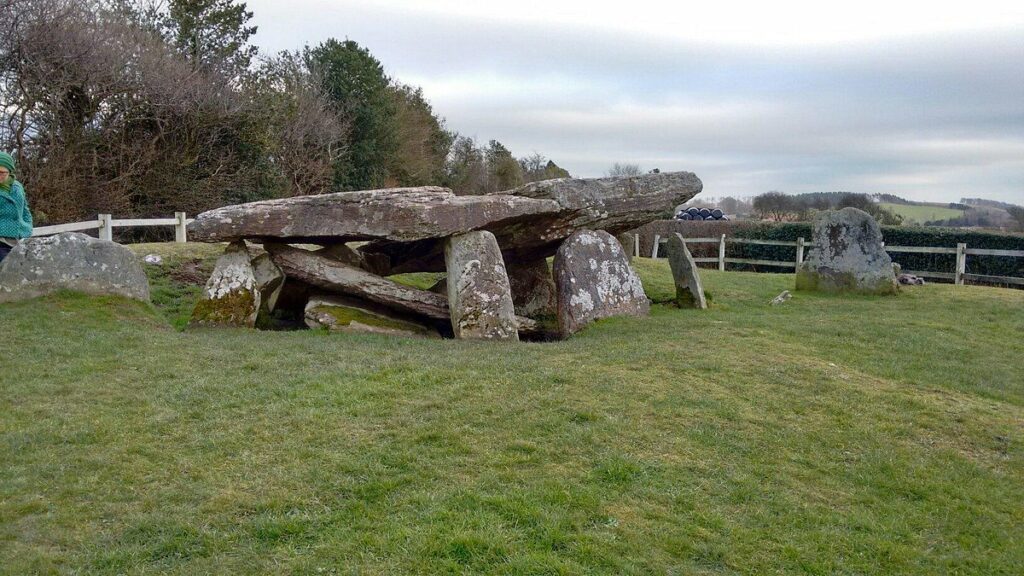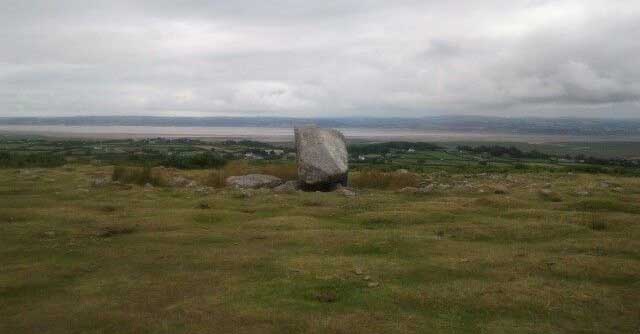“Arthur’s Stone” is a name associated with several ancient sites and structures in different part of the United Kingdom.
England
Chapel Lawn | Shropshire
In Chapel Lawn, Shropshire, there is a standing stone known as Arthur’s Stone or Hoarstone. It is associated with local folklor and is positioned near a prehistoric burial mound.
Clent Hills | Worcestershire
Clent Hills in Worcestershire is home to a group of standing stones known as Adam’s Hill and Eve’s Hill. One of these stones is sometimes referred to as Arthur’s Stone.
Cumbria
In Cumbria, there is a stone circle known as Long Meg and Her Daughters. Long Meg, the tallest stone in the circle, is sometimes referred to as Arthur’s Stone.
Dorstone | Herefordshire
It is said that this is the stone from which Arthur pulled out Excalibur. There is a confusion here: Excalibur was not the original Sword in the Stone. It is also said that Arthur is buried beneath the stone or that it marks the burial place of a king overcome by Arthur.
According to a legend, it was here that King Arthur slew a giant who left the impression of his elbows on one of the stones as he fell. Another source says it was King Arthur himself who left the elbow marks on the stone, and Arthur fighting a battle close by.

This is a Neolithic chambered tomb – or Dolmen – where the capstone (now broken in two) is estimated to weigh more than 25 tonnes. It has probably been used for both burials as well as focus for ritual ceremonies, but it’s uncertain as it has not been excavated.
Glastonbury | Somerset
Glastonbury Tor in Somerset is sometimes associated with Arthurian legends, and there are references to a stone known as Arthur’s Stone on the Tor. However, this connection is not universally accepted among historians.
Gloucestershire
Near the village of Slaughter, Gloucestershire, there is a Neolithic long barrow known as Arthur’s Stone. It is a megalithic burial site and, like other sites, is linked to King Arthur through folklore.
Peterchurch | Herefordshire
Near the village of Peterchurch, Herefordshire, there is an Arthur’s Stone, which is a large megalithic chambered tomb. It is also known as King Arthur’s Stone.
Shropshire
Arthur’s Stone, also known as Hoarstone, is a standing stone located near the village of Worthen in Shropshire, England. Like other stones with the same name, it is connected to local legends but lacks concrete historical evidence linking it to King Arthur.
Worcestershire
There is a standing stone known as Arthur’s Stone in Worcestershire, near the village of Mamble. This stone is associated with local folklore but has unclear archaeological connections to the Arthurian legend.
Wales
Cefnllys | Powys
Located near the village of Cefnllys in Powys, Wales, this Arthur’s Stone is a standing stone with a cross carved into it. It is often associated with local legends and traditions related to King Arthur.
Gower Peninsula | South Wales
Maen Ceti, also known as Arthur’s Stone, is a Neolithic burial chamber or cromlech. It consists of a large glacial erratic stone supported by smaller stones. It is said that, on his way to his final battle at Camlann, Arthur removed this stone from inside his boot and flung it into the distance, and it landed seven miles away at Cefn-y-Bryn. Maen Ceti is located on the southeastern slope of Cefn-y-Brn, near the village of Reynoldston in the Gower Peninsula, Swansea, South Wales.
At midnight on nights of the full moon, maidens from the Swansea area used to place cakes made of barley meal and honey, wetted with milk and well kneaded, on the stone. Then, on hands and knees, the maidens would crawl three times around the stone, this ritual being carried out to test the fidelity of their lovers. If the young men were faithful, they would come to the stone. If they did not arrive, the girls regarded this as a sign of their fickleness, or their intention never to marry.
Below the stone lies a spring called Ffynnon Fawr that is supposed to run according to the ebb and flow of the tide. The water used to be drunk from the palm of one hand while a wish was made. On nights with a full moon a ghostly figure wearing shining armour emerges from under the stone and proceeds to Llanrhidian. Those who have seen this mysterious spectral figure claim that it is King Arthur.

This is a Neolithic burial tomb and one of the first sites to be protected under the Ancient Monuments Act of 1882. It dates back to 2500 BC. In fact this relic is an ancient burial chamber with four stones supporting a millstone-grit capstone, making it a prominent feature on the ridge.
The huge capstone is thought to weigh about 25 tons, and has been partly split, either by King Arthur with Excalibur or by Saint David, who wished to prove that it was not a sacred stone. In 1870 the Egyptologist Sir Gardiner Wilkinson excavated the tomb, and claimed that the pathway followed by the ghostly apparition seen by many of King Arthur on a white steed, is the remains of a stone avenue.
Gower Peninsula
Another Arthur’s Stone, different from Maen Ceti (see above), is located on Cefn Bryn, a ridge on the Gower Peninsula. It is a Neolithic burial chamber with a large capstone.
Pembrokeshire
Carreg Coetan Arthur, located near Newport, Pembrokeshire, is a Neolithic burial chamber often referred to as Arthur’s Quoit or Arthur’s Stone.
St. Lythans | Vale of Glamorgan
Arthur’s Stone in St. Lythans is a Neolithic burial chamber with a large capstone, located in the Vale of Glamorgan, Wales. It is also known as St. Lythans Burial Chamber.
Scotland
Merrick | Dumfries and Galloway
Near Loch Trool in the Galloway Forest Park, Scotland, there is a large granite boulder known as Merrick’s (or Merrick) Stone, sometimes colloquially referred to as Arthur’s Stone.
Stennes | Orkney
On the Orkney Islands, there is a megalithic structure known as Arthur’s Stone in the Stenness parish. It is a large standing stone and part of the rich Neolithic archaeological landscape on the islands.
Note
A “hoarstone” typically refers to a standing stone or megalith with the name derived from hoar, meaning “ancient” or “old.” The term is often used in the context of folklore and local legends, and hoarstones are sometimes associated with myths, rituals, or historical events. The name “hoarstone” is not standardized, and it can be applied to various standing stones, especially those with historical or cultural significance in a particular locality. In some cases, hoarstones are beleieved to have healing properties or other mystical attributes.
Source
Physical topography in Britain and elsewhere.
